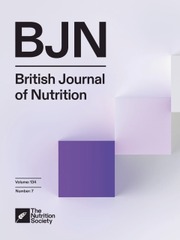Crossref Citations
This article has been cited by the following publications. This list is generated based on data provided by
Crossref.
Foltin, RW
Fischman, MW
Moran, TH
Rolls, BJ
and
Kelly, TH
1990.
Caloric compensation for lunches varying in fat and carbohydrate content by humans in a residential laboratory.
The American Journal of Clinical Nutrition,
Vol. 52,
Issue. 6,
p.
969.
de Graaf, C
Hulshof, T
Weststrate, JA
and
Jas, P
1992.
Short-term effects of different amounts of protein, fats, and carbohydrates on satiety.
The American Journal of Clinical Nutrition,
Vol. 55,
Issue. 1,
p.
33.
de Graaf, Cees
Stafleu, Annette
Staal, Petra
and
Wijne, Mark
1992.
Beliefs about the satiating effect of bread with spread varying in macronutrient content.
Appetite,
Vol. 18,
Issue. 2,
p.
121.
Foltin, RW
Rolls, BJ
Moran, TH
Kelly, TH
McNelis, AL
and
Fischman, MW
1992.
Caloric, but not macronutrient, compensation by humans for required-eating occasions with meals and snack varying in fat and carbohydrate.
The American Journal of Clinical Nutrition,
Vol. 55,
Issue. 2,
p.
331.
Warwick, Zoe S.
Hall, W.G.
Pappas, Theodore N.
and
Schiffman, Susan S.
1993.
Taste and smell sensations enhance the satiating effect of both a high-carbohydrate and a high-fat meal in humans.
Physiology & Behavior,
Vol. 53,
Issue. 3,
p.
553.
Rolls, BJ
and
Hammer, VA
1995.
Fat, carbohydrate, and the regulation of energy intake.
The American Journal of Clinical Nutrition,
Vol. 62,
Issue. 5,
p.
1086S.
Gustafsson, Kerstin
Asp, Nils-Georg
Hagander, Barbro
and
Nyman, Margareta
1995.
Satiety effects of spinach in mixed meals: Comparison with other vegetables.
International Journal of Food Sciences and Nutrition,
Vol. 46,
Issue. 4,
p.
327.
Warwick, Zoe S.
1996.
Probing the causes of high-fat diet hyperphagia: A mechanistic and behavioral dissection.
Neuroscience & Biobehavioral Reviews,
Vol. 20,
Issue. 1,
p.
155.
Myers, Michelle D
and
Epstein, Leonard H
1997.
The Effect of Dietary Fat on Salivary Habituation and Satiation.
Physiology & Behavior,
Vol. 62,
Issue. 1,
p.
155.
Cecil, J.E
Francis, J
and
Read, N.W
1999.
Comparison of the Effects of a High-Fat and High-Carbohydrate Soup Delivered Orally and Intragastrically on Gastric Emptying, Appetite, and Eating Behaviour.
Physiology & Behavior,
Vol. 67,
Issue. 2,
p.
299.
Melanson, Kathleen J.
Westerterp-Plantenga, Margriet S.
Arthur Campfield, L.
and
Saris, Wim H. M.
1999.
Blood glucose and meal patterns in time-blinded males, after aspartame, carbohydrate, and fat consumption, in relation to sweetness perception.
British Journal of Nutrition,
Vol. 82,
Issue. 6,
p.
437.
French, Stephen J.
1999.
The effects of specific nutrients on the regulation of feeding behaviour in human subjects.
Proceedings of the Nutrition Society,
Vol. 58,
Issue. 3,
p.
533.
French, Stephen J.
and
Cecil, Joanne E.
2001.
Oral, gastric and intestinal influences on human feeding.
Physiology & Behavior,
Vol. 74,
Issue. 4-5,
p.
729.
Raben, Anne
Agerholm-Larsen, Lisa
Flint, Anne
Holst, Jens J
and
Astrup, Arne
2003.
Meals with similar energy densities but rich in protein, fat, carbohydrate, or alcohol have different effects on energy expenditure and substrate metabolism but not on appetite and energy intake.
The American Journal of Clinical Nutrition,
Vol. 77,
Issue. 1,
p.
91.
Fischer, Karina
Colombani, Paolo C
and
Wenk, Caspar
2004.
Metabolic and cognitive coefficients in the development of hunger sensations after pure macronutrient ingestion in the morning.
Appetite,
Vol. 42,
Issue. 1,
p.
49.
Clifton, P.
2005.
Food diet and obesity.
p.
242.
Clifton, P.
2005.
Food, Diet and Obesity.
p.
242.
Mattes, R D
2006.
Beverages and positive energy balance: the menace is the medium.
International Journal of Obesity,
Vol. 30,
Issue. S3,
p.
S60.
Karamanolis, G.
and
Tack, J.
2006.
Nutrition and motility disorders.
Best Practice & Research Clinical Gastroenterology,
Vol. 20,
Issue. 3,
p.
485.
Ruden, Douglas M.
and
Lu, Xiangyi
2006.
Evolutionary conservation of metabolism explains howDrosophila nutrigenomics can help us understand human nutrigenomics.
Genes & Nutrition,
Vol. 1,
Issue. 2,
p.
75.

